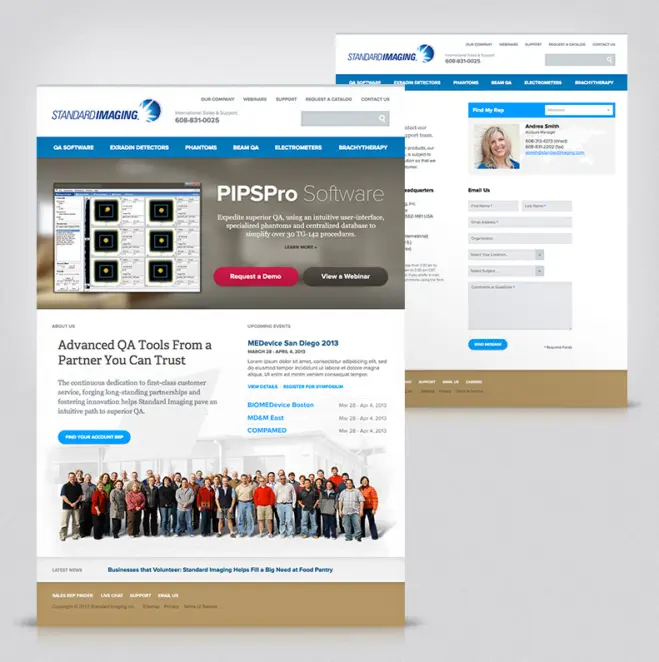Three Tiers of Manufacturing Web Design

B2B Manufacturers are technological paradoxes; relentlessly innovating equipment to open new markets, while simultaneous presenting cutting-edge solutions on sales and marketing platforms that are years out-of-date. The disconnect between product and promotion has been forgivable since B2B manufacturing purchasing behavior traditionally lags behind B2C. But the time of five-figure-plus sales being closed solely with phone calls and handshakes has passed, and manufacturing web design is becoming exponentially more important in the purchasing process.
- 30% of B2B buyers report that they research at least 90% of products online before purchasing (up from 22% in 2013)
- 66% of business buyers say they make a major purchase online at least once per month
- Only 12% of buyers want to meet in person with a sales representative
via: http://www.acquitygroup.com/docs/default-source/Whitepapers/acquitygroup_2014-b2bstudy.pdf
Manufacturers must be willing to adapt their web design and content in order to survive and capitalize on the tectonic shift to digital research and purchasing. Failing to change will lead to plummeting search rankings, ceding leads to competitors, and losing the ability to reach customers early in the purchasing cycle.
Manufacturing websites that succeed at attracting and capturing modern B2B purchasers exist on three tiers. While each tier produces results, every step up a rung means significant gains in exposure and conversions. Therefore, manufacturers should seek to continually refine their web design and content through iterative change or a complete overhaul.
Tier 1: Reference-Driven Website
The purpose of a reference-driven manufacturing website is to act as a digital brochure and user manual for internal sales people, distributors, and customers. Pages are heavy with content, technical specifications, and selling points, but lack opportunities for visitor engagement. Reference-driven sites contain a plethora of loosely structured information and, thus, are most effective when visitors already have an understanding of a product or when used as a touchpoint during a conversation between a sales-person and a customer.
Reference sites work best for manufacturers that are just starting to explore digital marketing – because the cost to create what is essentially a digital version of your brochure is significantly less than building all new content. The important factor is that all valuable product/corporate information gets online to be indexed by search engines. As people discover the site and interact with content, their behavior will help inform the next tier of web design.
Example of a Reference-Driven Site: Empire Bucket
Tier 2: Sales-Driven Website
"How success is measured," is the key difference between sales- and reference-driven websites. Manufacturers with reference sites simply want exposure, so performance could be judged by page views or ranking for critical keywords. Sales-driven websites attempt to bring visitors into the purchasing-cycle by tying targeted calls-to-action to popular content. Therefore, the metric for success is directly related to revenue, such as "quote requests" or "qualified leads".
In order to successfully make the leap from a reference-driven site to a sales-driven site, a company must understand how their current website is used – what search terms drive traffic, what pages lead people to email or call, and why people leave. These variables will create a map of visitor behavior from entry to exit and can inform the location and types of calls-to-action that will be successful. Furthermore, companies should have at least one full-time marketing employee on staff to help manage the site/contacts from the site, and a clearly defined approach in place to follow-up on inbound website leads.
Example of a Sales-Driven Site: Wisconsin Oven
Tier 3: Relationship-Driven Website
While sales-driven websites target customers that are ready to purchase, relationship-driven sites target to visitors throughout their lifespan with a company. Whether a casual browser, an existing customer that needs maintenance, or a student looking for educational opportunities, relationship-driven sites deliver content that engages the manufacturer's entire industry. A website that is more than a medium for commerce has two distinct advantages:
- Credibility – helping your customers and others in your industry is a much better to build trust than constantly selling
- Visibility – Helpful content gets used and shared. The more time people spend on, and engage with your site, the more likely it is that the site will funnel traffic away from competitors.
Creating the content required for a relationship-driven website is time-consuming. Manufacturers that want to move from a sales-driven site to a relationship-driven site should have a comfortable stream of incoming leads and a firm grasp on their website analytics. Marketers need the data and the existing results to justify why they're investing in capturing eyeballs and winning hearts, above and beyond the needs of immediate, motivated buyers.
Example of a Relationship-Driven Site: Standard Imaging
An excellent manufacturing website will not trump the value of having a fantastic product, a savvy sales team, or a high-quality service department. However, an excellent website will translate and transmit competitive advantages to a larger digital audience. The key is to constantly improve – start with a reference site that displays and organizes important information and work diligently to advance up the ladder to an effective, relationship-driven website.